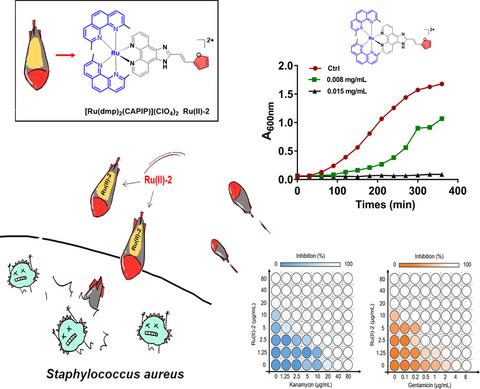当前位置:
X-MOL 学术
›
Chem. Bio. Drug Des.
›
论文详情
Our official English website, www.x-mol.net, welcomes your
feedback! (Note: you will need to create a separate account there.)
Identification of ruthenium (II) complexes with furan-substituted ligands as possible antibacterial agents against Staphylococcus aureus
Chemical Biology & Drug Design ( IF 3.2 ) Pub Date : 2021-08-28 , DOI: 10.1111/cbdd.13943 Xiangwen Liao 1 , Jing Wang 1 , Guijuan Jiang 1 , Mao Lingyu 1 , Guangbin Jiang 2 , Jintao Wang 1 , Bin Huang 3
Chemical Biology & Drug Design ( IF 3.2 ) Pub Date : 2021-08-28 , DOI: 10.1111/cbdd.13943 Xiangwen Liao 1 , Jing Wang 1 , Guijuan Jiang 1 , Mao Lingyu 1 , Guangbin Jiang 2 , Jintao Wang 1 , Bin Huang 3
Affiliation

|
The growing burden of antibiotic resistance worldwide calls for developing new classes of antimicrobial strategy. Recently years, the use of adjuvants that rescue antibiotics identified as a promising strategy for overcoming bacterial resistance. In this study, three ruthenium complexes functionalized with furan-substituted ligands([Ru(phen)2(CAPIP)](ClO4)2 (Ru(Ⅱ)-1), [Ru(dmp)2(CAPIP)](ClO4)2 (Ru(Ⅱ)-2) and [Ru(dmb)2(CAPIP)](ClO4)2 (Ru(Ⅱ)-3) (dmb=4,4′-dimethyl-2,2′-bipyridine, phen=1,10-phenanthroline, dmp=2,9-dimethyl-1,10-phenanthroline, CAPIP=(E)-2- (2-(furan-2-yl)vinyl)-1H-imidazo[4,5-f][1,10]phenanthroline)) were designed and synthesized. The antimicrobial activities of all compounds against S. aureus were assessed by growth inhibition assays. The MIC values of three complexes range from 0.015 to 0.050 mg/ml. Subsequently, the Ru(II)-2 complexes which exhibited strongest antibacterial activity were further tested against bacteria biofilms formation and toxin secretion. In addition, aimed to test whether ruthenium complexes have potential value as antimicrobial adjuvants, the synergism between Ru(Ⅱ)-2 and some antibiotics against S. aureus were examined through checkerboard method. Interestingly, Ru(Ⅱ)-2 could not only effectively inhibit biofilms formation of S. aureus and inhibit the hemolysin toxin secretion, but also selectivity show synergism with two common antibiotics. More importantly, mouse infection study also verified Ru(Ⅱ)-2 were highly effective against S. aureus in vivo.
中文翻译:

鉴定具有呋喃取代配体的钌 (II) 配合物作为抗金黄色葡萄球菌的可能抗菌剂
世界范围内日益增加的抗生素耐药性负担要求制定新的抗菌策略。近年来,使用拯救抗生素的佐剂被确定为克服细菌耐药性的有希望的策略。在这项研究中,三个被呋喃取代的配体官能化的钌配合物([Ru(phen) 2 (CAPIP)](ClO 4 ) 2 ( Ru(Ⅱ)-1 ), [Ru(dmp) 2 (CAPIP)](ClO 4 ) 2 ( Ru(Ⅱ)-2 ) 和 [Ru(dmb) 2 (CAPIP)](ClO 4 ) 2 ( Ru(Ⅱ)-3) (dmb=4,4'-二甲基-2,2'-联吡啶, phen=1,10-菲咯啉, dmp=2,9-二甲基-1,10-菲咯啉, CAPIP=(E)-2- (2 -(furan-2-yl)vinyl)-1H-imidazo[4,5-f][1,10]phenanthroline)))被设计合成。所有化合物对S的抗菌活性。通过生长抑制试验评估金黄色葡萄球菌。三种复合物的 MIC 值范围为 0.015 至 0.050 mg/ml。随后,进一步测试了表现出最强抗菌活性的Ru(II)-2配合物对细菌生物膜形成和毒素分泌的影响。此外,旨在测试钌配合物是否具有作为抗菌佐剂的潜在价值,Ru(Ⅱ)-2与一些抗生素对S的协同作用。金黄色葡萄球菌采用棋盘法检测。有趣的是,Ru(Ⅱ)-2不仅能有效抑制S的生物膜形成。金黄色葡萄球菌并抑制溶血素毒素的分泌,还能选择性地与两种常见的抗生素表现出协同作用。更重要的是,小鼠感染研究也证实了Ru(Ⅱ)-2对S具有高效性。体内金黄色葡萄球菌。
更新日期:2021-10-29
中文翻译:

鉴定具有呋喃取代配体的钌 (II) 配合物作为抗金黄色葡萄球菌的可能抗菌剂
世界范围内日益增加的抗生素耐药性负担要求制定新的抗菌策略。近年来,使用拯救抗生素的佐剂被确定为克服细菌耐药性的有希望的策略。在这项研究中,三个被呋喃取代的配体官能化的钌配合物([Ru(phen) 2 (CAPIP)](ClO 4 ) 2 ( Ru(Ⅱ)-1 ), [Ru(dmp) 2 (CAPIP)](ClO 4 ) 2 ( Ru(Ⅱ)-2 ) 和 [Ru(dmb) 2 (CAPIP)](ClO 4 ) 2 ( Ru(Ⅱ)-3) (dmb=4,4'-二甲基-2,2'-联吡啶, phen=1,10-菲咯啉, dmp=2,9-二甲基-1,10-菲咯啉, CAPIP=(E)-2- (2 -(furan-2-yl)vinyl)-1H-imidazo[4,5-f][1,10]phenanthroline)))被设计合成。所有化合物对S的抗菌活性。通过生长抑制试验评估金黄色葡萄球菌。三种复合物的 MIC 值范围为 0.015 至 0.050 mg/ml。随后,进一步测试了表现出最强抗菌活性的Ru(II)-2配合物对细菌生物膜形成和毒素分泌的影响。此外,旨在测试钌配合物是否具有作为抗菌佐剂的潜在价值,Ru(Ⅱ)-2与一些抗生素对S的协同作用。金黄色葡萄球菌采用棋盘法检测。有趣的是,Ru(Ⅱ)-2不仅能有效抑制S的生物膜形成。金黄色葡萄球菌并抑制溶血素毒素的分泌,还能选择性地与两种常见的抗生素表现出协同作用。更重要的是,小鼠感染研究也证实了Ru(Ⅱ)-2对S具有高效性。体内金黄色葡萄球菌。











































 京公网安备 11010802027423号
京公网安备 11010802027423号